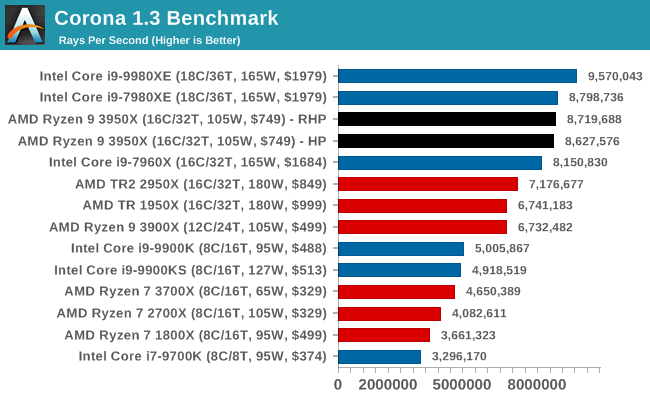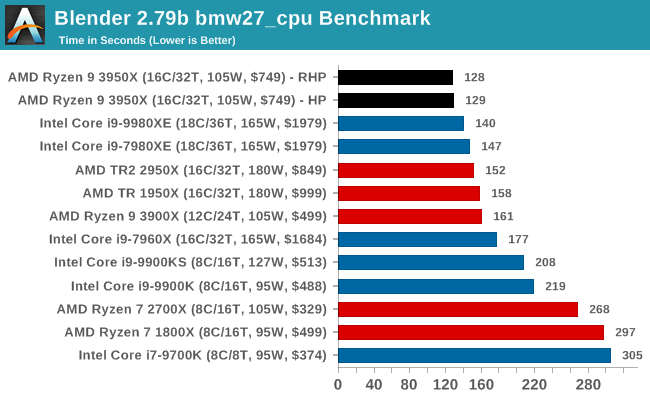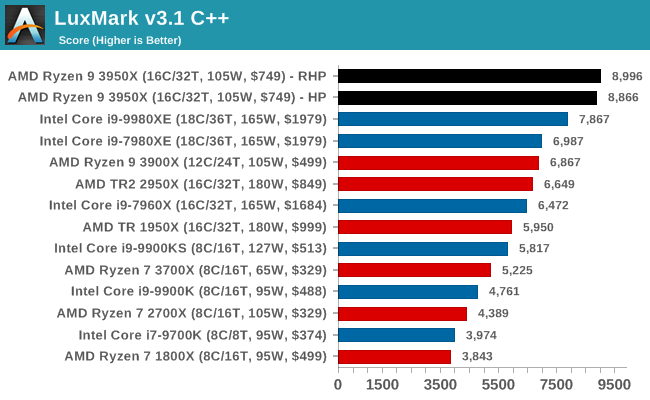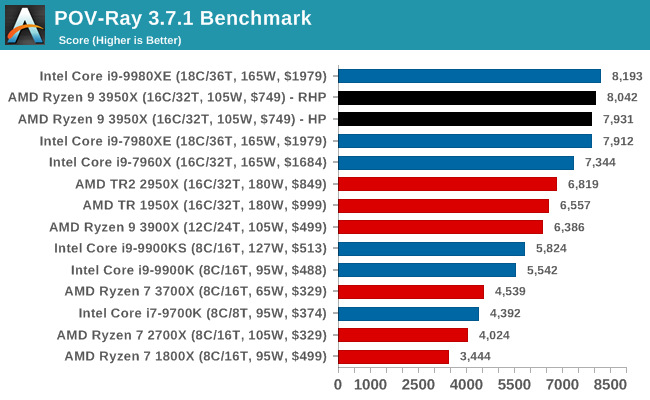The AMD Ryzen 9 3950X Review: 16 Cores on 7nm with PCIe 4.0
by Dr. Ian Cutress on November 14, 2019 9:00 AM ESTCPU Performance: Rendering Tests
Rendering is often a key target for processor workloads, lending itself to a professional environment. It comes in different formats as well, from 3D rendering through rasterization, such as games, or by ray tracing, and invokes the ability of the software to manage meshes, textures, collisions, aliasing, physics (in animations), and discarding unnecessary work. Most renderers offer CPU code paths, while a few use GPUs and select environments use FPGAs or dedicated ASICs. For big studios however, CPUs are still the hardware of choice.
All of our benchmark results can also be found in our benchmark engine, Bench.
Corona 1.3: Performance Render
An advanced performance based renderer for software such as 3ds Max and Cinema 4D, the Corona benchmark renders a generated scene as a standard under its 1.3 software version. Normally the GUI implementation of the benchmark shows the scene being built, and allows the user to upload the result as a ‘time to complete’.
We got in contact with the developer who gave us a command line version of the benchmark that does a direct output of results. Rather than reporting time, we report the average number of rays per second across six runs, as the performance scaling of a result per unit time is typically visually easier to understand.
The Corona benchmark website can be found at https://corona-renderer.com/benchmark

Intel's HEDT chips are quite good at Corona, but if we compare the 3900X to the 3950X, we still see some good scaling.
Blender 2.79b: 3D Creation Suite
A high profile rendering tool, Blender is open-source allowing for massive amounts of configurability, and is used by a number of high-profile animation studios worldwide. The organization recently released a Blender benchmark package, a couple of weeks after we had narrowed our Blender test for our new suite, however their test can take over an hour. For our results, we run one of the sub-tests in that suite through the command line - a standard ‘bmw27’ scene in CPU only mode, and measure the time to complete the render.
Blender can be downloaded at https://www.blender.org/download/

AMD is taking the lead in our blender test, with the 16-core chips easily going through Intel's latest 18-core hardware.
LuxMark v3.1: LuxRender via Different Code Paths
As stated at the top, there are many different ways to process rendering data: CPU, GPU, Accelerator, and others. On top of that, there are many frameworks and APIs in which to program, depending on how the software will be used. LuxMark, a benchmark developed using the LuxRender engine, offers several different scenes and APIs.
In our test, we run the simple ‘Ball’ scene on both the C++ code path, in CPU mode. This scene starts with a rough render and slowly improves the quality over two minutes, giving a final result in what is essentially an average ‘kilorays per second’.

Despite using Intel's Embree engine, again AMD's 16-cores easily win out against Intel's 18-core chips, at under half the cost.
POV-Ray 3.7.1: Ray Tracing
The Persistence of Vision ray tracing engine is another well-known benchmarking tool, which was in a state of relative hibernation until AMD released its Zen processors, to which suddenly both Intel and AMD were submitting code to the main branch of the open source project. For our test, we use the built-in benchmark for all-cores, called from the command line.
POV-Ray can be downloaded from http://www.povray.org/

POV-Ray ends up with AMD 16-core splitting the two Intel 18-core parts, which means we're likely to see the Intel Core i9-10980XE at the top here. It would have been interesting to see where an Intel 16-core Core-X on Cascade would end up for a direct comparison, but Intel has no new 16-core chip planned.











206 Comments
View All Comments
tmanini - Thursday, November 14, 2019 - link
depends on your development needs: in the article is states dual-channel memory. Not 4 or 6 channel.Spunjji - Thursday, November 14, 2019 - link
I have a question about the power numbers - do they look significantly different with only one thread loaded per core?ksec - Thursday, November 14, 2019 - link
If we look at the benchmark running on Open Source program, it is clear AMD tends to have a much higher chance of performance being on par or beating Intel. I wonder how much optimisation from compiler to other library giving advantage to Intel and not to AMD.Maxiking - Thursday, November 14, 2019 - link
Pretty sad cpu, bottlenecking ancient 1080gtx at 1080p. Just lolQasar - Thursday, November 14, 2019 - link
come on maxiking, the 9xxx cpu's are that bad.. after all they need the extra frequency just to keep what little performance advantage they, at times, barely still have.stux - Thursday, November 14, 2019 - link
Great review, but where are the compilation benchmarks?Ian Cutress - Thursday, November 14, 2019 - link
I was having issues getting the benchmark to work on Win 10 1909, and didn't have time to debug and retest. I'm hoping to fix it for the next benchmark suite update.stux - Thursday, November 14, 2019 - link
Thanks Ian, looking forward to the update.kc77 - Thursday, November 14, 2019 - link
I don't see the TDP comparisons with the Intel rig. Are they there? I see AMD TDP mentioned but not the Intel parts.willis936 - Thursday, November 14, 2019 - link
I moved to the midwest recently and I have to wonder: Who is christ and why does everyone care what CPU he has?